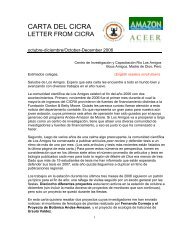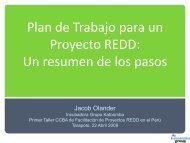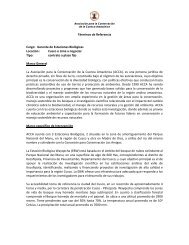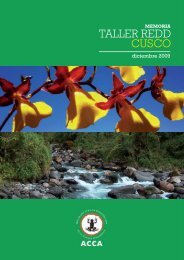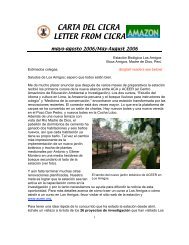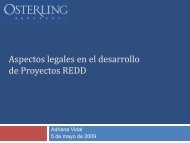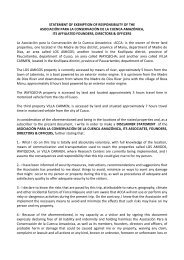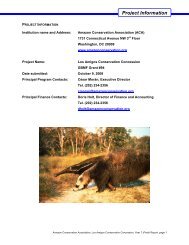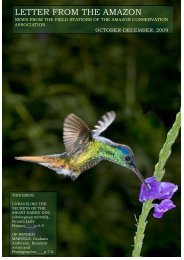LETTER FROM THE AMAZON - Amazon Conservation Association
LETTER FROM THE AMAZON - Amazon Conservation Association
LETTER FROM THE AMAZON - Amazon Conservation Association
Create successful ePaper yourself
Turn your PDF publications into a flip-book with our unique Google optimized e-Paper software.
Letter from the <strong>Amazon</strong> January-March, 2010<br />
RESEARCH: Recent<br />
Publications<br />
Mariajose Deza: arachnids of CICRA<br />
Mariajose received her BA from<br />
la Universidad Nacional Agraria<br />
la Molina. As an ACCA grantee,<br />
she studied the abundance and<br />
diversity of spiders (Aranaeidae)<br />
at CICRA for her certification as<br />
a biologist. Mariajose’s study,<br />
Diversity and species richness of the family Araneidae<br />
(Arachnida, Araneae) in CICRA (Madre de Dios—Peru)<br />
was completed and accepted for publication in Ecologia<br />
Aplicada this past year.<br />
Editorial continued below.<br />
Alison Ravenscraft: Ants and plants<br />
Alison Ravenscraft, Harvard ’09 was featured<br />
in our last letter in current research (p. 3).<br />
Many people traveling out to CICRA’s trail 6,<br />
especially in the crepuscular hours, return to<br />
the comedor with puzzled faces and questions<br />
about the ‘ghost town.’ Trail 6 has become a<br />
phantasmagorical trek through the woods. To<br />
exclude herbivores, Alison and her team have<br />
hung 52 large, white mosquito nets, each<br />
resting with an ethereal stateliness over their<br />
respective Cordia nodosa tree. The exclusions<br />
assess whether the plant invests a significant<br />
amount of resources in its resident ant colony.<br />
Ants defend the tree from the insects that eat<br />
it; but, if they are excluded, are ant colonies<br />
detrimental or beneficial to the tree? In<br />
January, Alison and one field assistant<br />
recently changed the mosquito nets of the<br />
ghost town; sadly, the new nets are a little<br />
more austere than the last ones, lacking the<br />
lovely aesthetic touch of the last bunch: a lacy<br />
fringe. Keep up with Alison and her adventures<br />
at holahormigas@blogspot.com. Sarah Federman.<br />
Photo of Alison at her ghost city by Sarah<br />
Federman.<br />
Mariajose collected over 4,000 individuals which were<br />
distributed across at least 25 genera and totaling 154<br />
species. Sarah Federman. Spider at CICRA by<br />
Katharine Fountain (top) Sarah Federman (bottom).<br />
New taxonomic classification of a frog from<br />
Wayqecha<br />
A small frog from the locality of<br />
Quebrada Toccoruyoc and Esperanza<br />
at Wayqecha Biological Station<br />
previously described and classified as<br />
“Hyla” antoniiochoai was reclassified<br />
into the genus Gastrotheca as a result of new specimen<br />
collections. Aside from general morphology, the<br />
advertisement call, morphological distinctions between<br />
adults and juveniles, and habitat have been described.<br />
Among the six new specimens collected were three<br />
juveniles and three adults. Among the adults was a<br />
brooding female, the first female collected as the authors<br />
believe the female reported in the previous study was<br />
actually a juvenile. Gastrotheca by Alessndro Catenazzi.<br />
Editorial continued below.<br />
To eat or not to eat<br />
Mercury used in gold mining pollutes the<br />
waters of Madre de Dios, and those who<br />
know it, often reject fish in restaurant<br />
menus. But, how much are the fish in<br />
Madre de Dios contaminated by mercury,<br />
really? That question was answered by<br />
Dr. Luis Fernandez, at the Carnegie<br />
Institution for Science. Funded in part by<br />
CICRA’s grant program. Dr. Fernandez<br />
determined the mercury content of dorsal<br />
muscle in eleven fish species and found<br />
that a single meal of the large<br />
carnivorous cat fish zumgaro (Zungaro<br />
zungaro) and mota (Calophysus<br />
macropterus) can overdose you with the<br />
heavy metal, while the smaller plant<br />
eating fish paco (Piaractus<br />
brachypomus) and boquichico<br />
(Prochilodus nigricans) are safe to eat.<br />
Good Friday followers will now know how<br />
to pick their fish. Stay tuned for results on<br />
more fish species soon. Adrian Tejedor.<br />
Photo: Looking for fish at the market. Puma<br />
zungaro (Pseudoplatystoma tigrinum) by Luis<br />
Fernandez.<br />
SPOTLIGHTS<br />
Characteristics which distinguish this frog from other<br />
Gastrotheca species are its comparatively small size and<br />
habitat of bromeliads. Some of the specimens in this<br />
collection were found in bromeliads over 6m high, about<br />
the height of Wayqecha’s<br />
canopy; this is the first report<br />
of a Gastrotheca at such<br />
heights. It is possible that they<br />
inhabit both the bromeliad<br />
habitat and brush. The frogs<br />
have an altitudinal range of<br />
2800-3300 masl, from which they appear to share part of<br />
their habitat with two other species of marsupial frogs in<br />
the region: G. excubitor and G. ochoai. Laura Morales.<br />
Juvenile Gastrotheca by Alessandro Catenazzi.<br />
7



